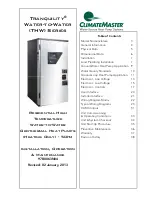
T H E S M A R T S O L U T I O N F O R E N E R G Y E F F I C I E N C Y
9
c l i m a t e m a s t e r. c o m
Tr a n q u i l i t y
®
W a t e r- t o - W a t e r T H W S e r i e s
R e v i s e d : 0 2 J a n u a r y, 2 0 1 3
Typical open loop piping is shown in Figure 2. Shut off valves
should be included in case of servicing. Boiler drains or other
valves should be ‘tee’d’ into the line to allow acid fl ushing of
just the heat exchanger. Pressure temperature plugs should
be used so that fl ow and temperature can be measured.
Piping materials should be limited to PVC SCH80 or copper.
Due to the pressure and temperature extremes, PVC SCH40
is not recommended. Water quantity should be plentiful and
of good quality. Consult Table 2 for water quality guidelines.
The unit can be ordered with either a copper or cupro-nickel
water heat exchanger. Copper is recommended for closed
loop systems and open loop ground water systems that are
not high in mineral content or corrosiveness. In conditions
anticipating heavy scale formation or in brackish water, a
cupro-nickel heat exchanger is recommended. In ground
water situations where scaling could be heavy or where
biological growth such as iron bacteria will be present, a
closed loop system is recommended. Heat exchanger coils
may over time lose heat exchange capabilities due to a build
up of mineral deposits inside. These can be cleaned only by
a qualifi ed service mechanic as acid and special pumping
equipment are required.
Expansion Tank and Pump
Use a closed, bladder-type expansion tank to minimize mineral
formation due to air exposure. The expansion tank should be
sized to handle at least one minute run time of the pump to
prevent premature pump failure using its drawdown capacity
rating. The pump should be sized to the home’s domestic
water load 19-34 l/m plus the heat pump water load. Discharge
water from the unit is not contaminated in any manner and can
be disposed of in various ways depending on local building
codes; i.e. recharge well, storm sewer, drain fi eld, adjacent
stream or pond, etc. Most local codes forbid the use of
sanitary sewer for disposal. Consult your local building and
zoning department to assure compliance in your area.
Water Control Valve
Note the placement of the water control valve. Always
maintain water pressure in the heat exchanger by placing
water control valves at the outlet of the unit to prevent
mineral precipitation. Pilot operated or Taco slow closing
valve’s solenoid valves are recommended to reduce water
hammer. If water hammer persists, a mini-expansion tank can
be mounted on the piping to help absorb the excess hammer
shock. Insure that the total ‘VA’ draw of the valve can be
supplied by the unit transformer. For instance the Taco slow
closing valve can draw up to 35VA. This can overload smaller
40 or 50 VA transformers depending on the other controls
employed. A typical pilot operated solenoid valve draws
approximately 15VA. Note the special wiring diagram of the
AVM valve (Figure 9).
Flow Regulation
Flow regulation can be accomplished by two methods. First,
most water control valves have a built in fl ow adjustment.
By measuring the pressure drop through the unit heat
exchanger, fl ow rate can be determined and compared
to Table 8. Simply adjust the water control valve until the
desired fl ow is achieved. Secondly, a fl ow control device may
be installed. The devices are typically an orifi ce of plastic
material that is designed to allow a specifi ed fl ow rate. These
are mounted on the outlet of the water control valve. On
occasion, these valves can produce a velocity noise that
can be reduced by applying some back pressure. This is
accomplished by slightly closing the leaving isolation valve of
the well water setup.
Low Temperature Cutout
The water low temperature cutout setpoint should be
activated to avoid freeze damage to the unit. Consult the low
temperature cutout section of the controls description for
instructions.
CAUTION!
CAUTION!
Refrigerant pressure activated water regulating
valves should never be used with this equipment.
Ground-Water Heat Pump Systems
























